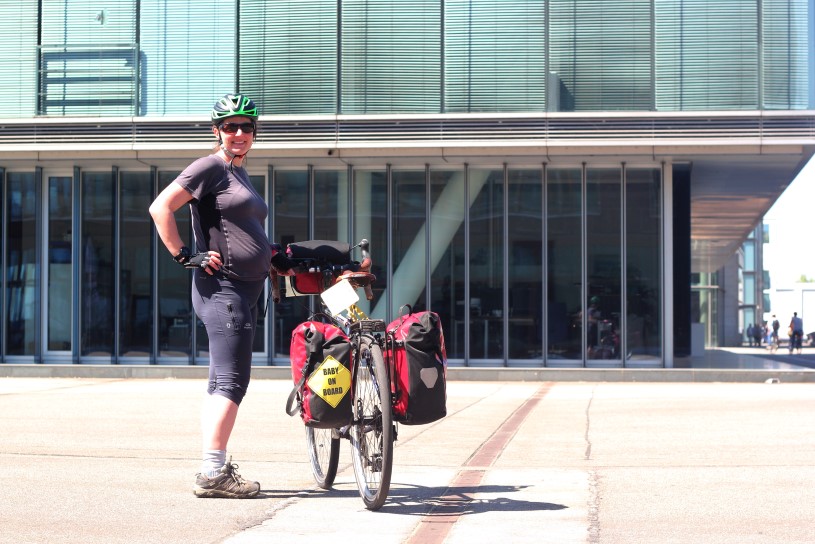
Meandering down the banks of the Elbe on a sunny May morning, we were surrounded by cyclists of all tribes. Parents and children rode next to old men on novelty bikes. Lycra-clad women flew past at speed as young couples gossiped on sit-up-and-begs. Commuters picked their way through the crowds, while my husband Tim and I trundled forward on our pannier-laden bicycles, heading for the Danish border.
Our plan was to cycle through Denmark on the North Sea Cycle Route, which weaves up the west coast of Jutland. We were drawn by the pastries, the 400-odd miles of largely traffic-free cycling on offer, and the flat topography. These factors were particularly important to us on this trip because I was six months pregnant.
I cycled throughout my pregnancy, right up until my due date and beyond. I found it easier than walking, because the weight was off my legs. It was one of the few times I felt almost normal, able to cruise along and forget for a moment that I was carrying around an infant and a couple of pints of amniotic fluid.
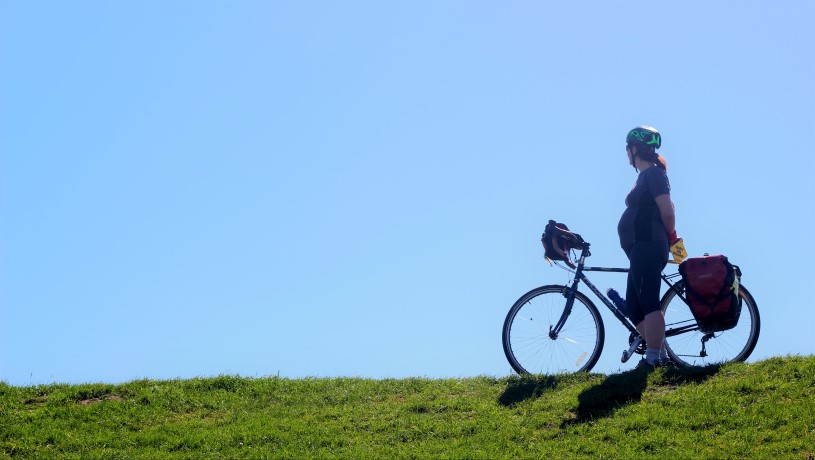
However, the extra cargo did mean our priorities were somewhat changed when it came to choosing a destination for our annual cycle tour. Finding quiet roads and car-free routes felt more important than normal, as our risk threshold was lowered. Hills are also disproportionately harder when pregnant: a combination of the extra weight and having to keep two hearts beating rather than one.
All of which drew our attention to Denmark’s west coast. The area is marketed as a child-friendly destination, which we interpreted as including children as-yet-unborn. Our plan was to follow the North Sea Cycle Route all the way to Skagen at the tip of the Danish peninsular, the famous point where two seas collide.
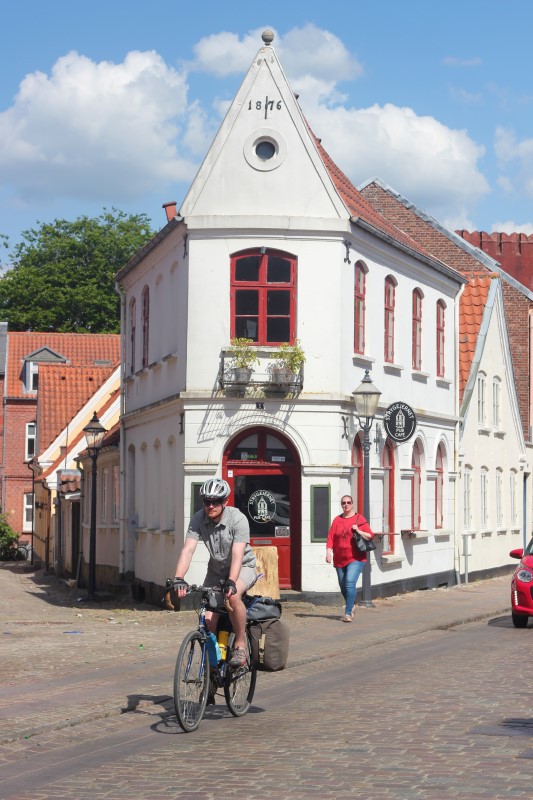
Northern Europe
We soon discovered that Northern Europe was everything we had hoped for, despite an epic journey to get there. We had decided not to take any flights for our holiday to avoid the hassle of getting bikes to and from airports and packing them up safely. Plus, of course, it would be better for the environment. Instead of simply jumping on a plane, we made reaching the start line into part of the journey.
And what a journey it turned out to be.
It started with a train to London where we were greeted at King’s Cross station by Harry and Megan in cardboard cutout form, celebrating their wedding day. Train staff marked the occasion by handing out tiny Union Jacks (which stayed on our bikes all the way across Denmark) and scones with jam (which did not last as long).
This was followed by a Eurostar train to Brussels, where our arrival coincided with a Gay Pride event. We passed an evening roaming the streets, soaking up the vibe and eating waffles.
The next part of the journey was the big one: an overnight bus to Hamburg. We had heard good things about Flixbus and their bike-friendly policies but, as we stood on a dark backstreet at 1am holding tightly to our touring bikes, we began to have our doubts. Sure enough though, the bus turned up when the timetable said it would, the driver strapped our bikes to a rack on the back and we slept all the way to northern Germany. From there, our plan was to cycle up the Elbe River for a couple of days, before crossing the border into Denmark.
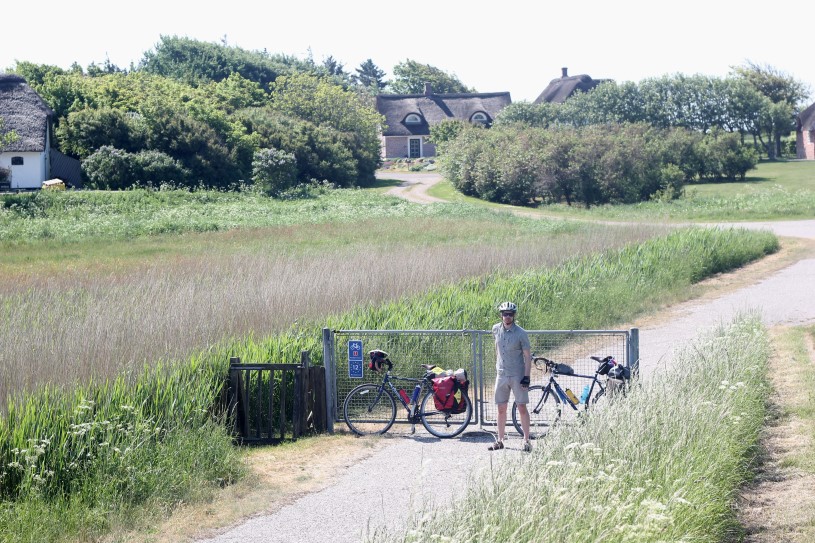
First class camping
On first impressions, Northern Europe was everything we had hoped it would be. The terrain was flat, the banks of the Elbe were bustling and it was pleasantly warm. The only fly in the ointment came when evening fell and we realised that everywhere was closed.
It took us a while to work out what was going on. We usually do a cycle tour in May or June most years. The days are longer, the weather is warm, and places are just beginning to open up for the tourist season – but not here. In northern Germany and Denmark, the Pentecost is a serious business; all the shops and restaurants close for the duration of the Whitsunday holiday. It meant the first days of our jaunt through northern Europe were heavily reliant on the chewy bars we’d brought for emergencies.
Once we arrived in Denmark, the route followed the coast. We pedalled amidst sand dunes on a broad, empty trail. On our first night, we headed in search of the campsite marked on our map. Demarcated with huge Danish flags, it was visible from a mile away. As we got closer we realised that it was one of those big, camping-and-caravaning sites and we braced ourselves for a high Scandinavian price tag.
“Twelve quid for both of us”, Tim said as he strode out of reception looking relieved, “And that includes showers, wi-fi, a fully equipped kitchen, and use of the TV room”.
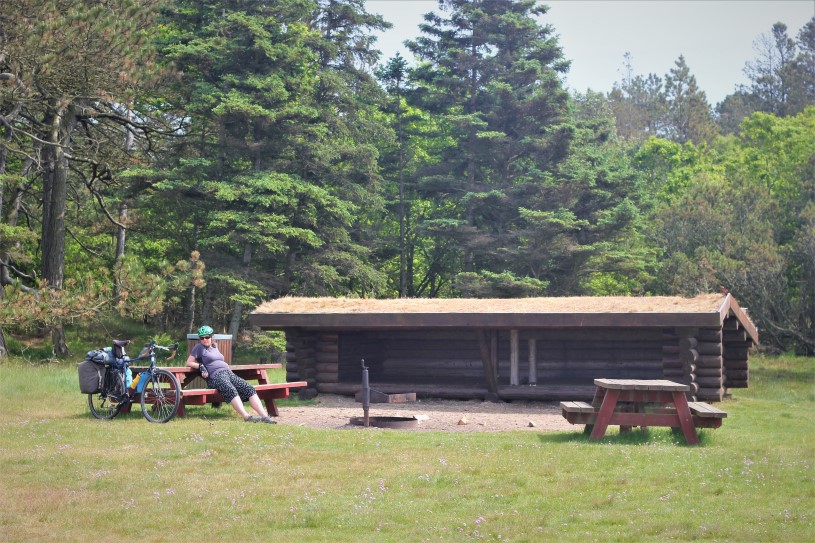
Many aspects of camping when pregnant are little different from normal, but what I was looking forward to least was having to sit on the floor. It may sound like a small thing but even getting up and down could be a pain, so spending an entire evening sitting on the grass, leaning over a camping stove, did not sound like fun.
As such, it was a pleasant surprise to find that every campsite we used in Denmark had some combination of a kitchen (so we could cook while standing up), a dining area (so we could eat at a table) and a lounge (so we could read our books in a comfy chair). They often had shops on site, some had swimming pools, and all were generally peaceful. On several occasions we would find ourselves in sole charge of the kitchen or the only occupants of a cosy TV room.
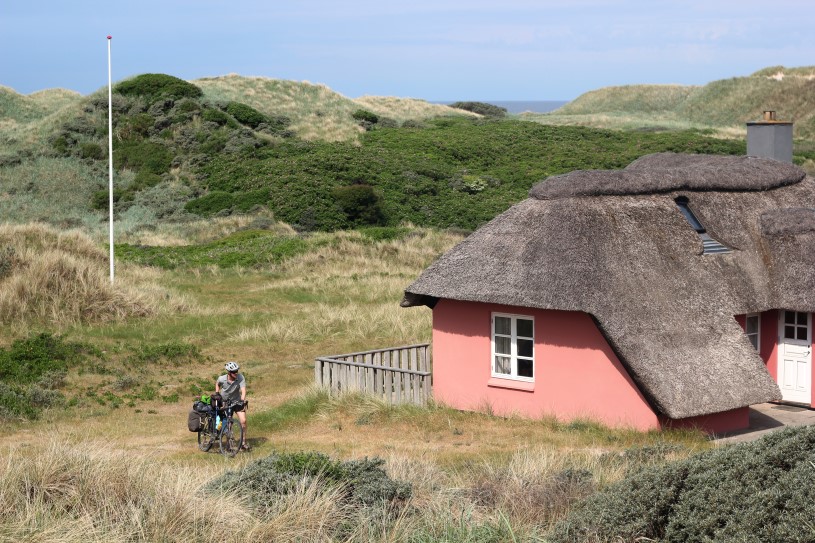
High-speed grannies
After a relaxing evening, we woke the following morning to sunshine and glorious blue skies. The coastal cycling route wound its way between a dyke (erected to minimise flood risk) and forest trails, teasing us with occasional glimpses of the sea. We passed more cyclists than we did motorists that morning, and even they were few and far between. Most of the time, we had the world to ourselves. Passing through the town of Esbjerg, we escaped the heat with a waffle and ice cream break. Handing my Euros over the counter, I asked the shop owner if it was always this hot.
“No. It’s normally more like Scotland, only colder,” he replied. “In fact, I can’t remember a summer like this for 20 years. And it’s not even summer!”
It may have been unseasonably warm for May but the proliferation of rooftop solar panels suggested that sunshine was not unprecedented. Many of the rural houses and barns we passed had huge, steep-sided roofs. And many of those were covered in giant banks of solar panels. The most I counted on a single roof was 96.
It is not solar power for which Denmark is best known however, but wind. We passed many turbines on the west coast. They help produce 30% of the country’s energy requirements and 60% of its electricity. Unfortunately, those spinning turbines only meant one thing for us cyclists: headwinds.
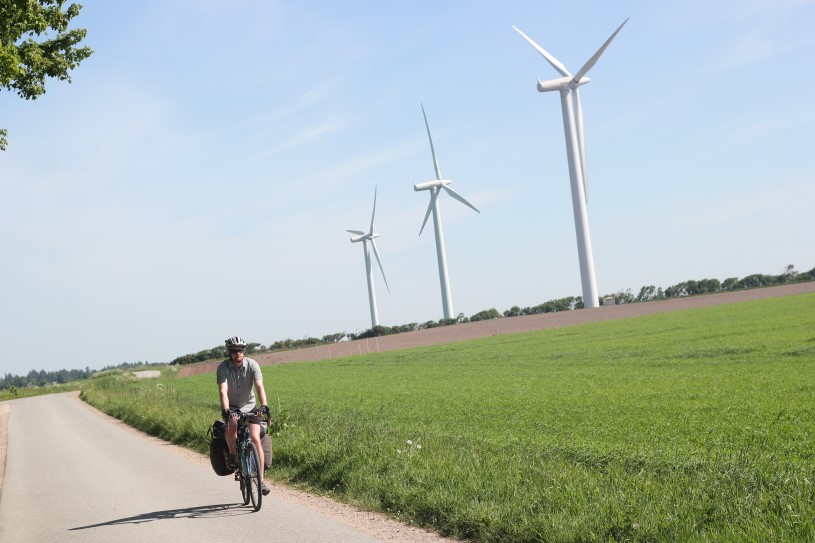
We chose that evening’s campsite for its proximity to the sea: walking distance from the tent, even barefoot. Despite the hot weather, the North Atlantic remained bracing so our excursion was loud but brief.
Over the coming days, our route wiggled through grass covered dunes, passing the many World War II bunkers that still look out to sea. The dunes meant it was less flat than anticipated and frequent patches of sand meant it was often quite hard going. Emerging onto an empty stretch of road late one morning, a couple of grey-haired women shot past, leaving us for dust. We caught them at a café later that day, a glass of white wine in hand as they waited for the batteries of their e-bikes to recharge.
“They’re fantastic. We can pedal the easy bits and use the engine to give us a boost when we need it,” explained one of the ladies, between sips of wine. “The only problem is that mine is stuck on full speed!”
They used to tour on ‘normal’ bikes but, as they got older, they found themselves doing shorter and shorter distances. Now, with a little electronic assistance, they could get back to longer journeys.
It was not just the older folks that were filling the Danish bike lanes. The kids were at it too. From our café table that lunchtime, we saw little children on back seats and balance bikes, and lots of parents using bicycle trailers as their regular prams. Best of all, we found that no one batted an eyelid about me cycling when pregnant. At home, I was constantly asked whether it was safe to ride a bike. The question was often posed rhetorically, with the answer implied in the sceptical tone. In Denmark, cycling was just part of everyday life, whether you were old, young, pregnant or otherwise.
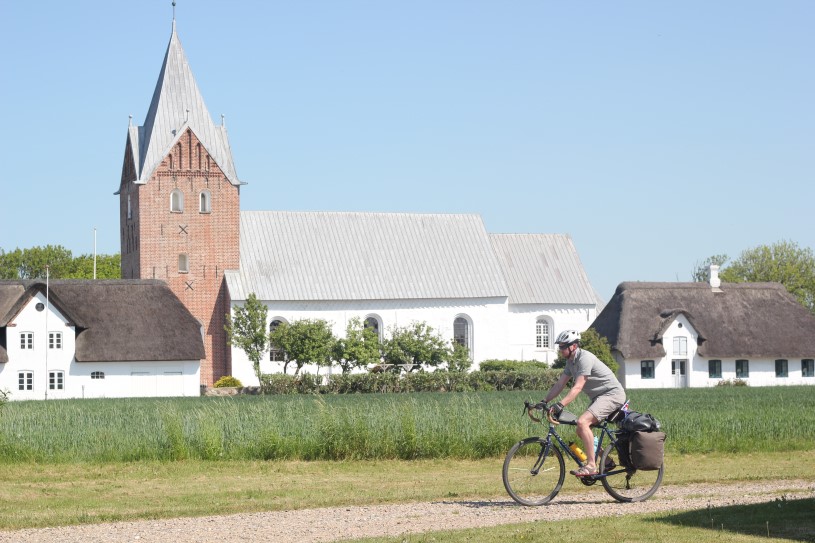
Coasting north
We waved goodbye to the high-speed grannies, left the café and continued north. The skies remained blue as we rode along the tiny fingers of land that run up the west coast. After a quick ferry hop at Thyboron, we fought against a headwind into Thy National Park where the first of several snakes shot past my front wheel.
Denmark had a lot more wildlife than I had expected. As well as snakes (which we suspect were adders), we saw deer, squirrels, lizards, butterflies, and all manner of birds. Neither of us knows much about birds but even we were able to pick out the distinctive calls of the cuckoos that were in earshot of our campsite each night.
As the name suggests, the North Sea Cycle Route largely follows the coast. How closely it does that varies greatly but one particular day we spent an entire afternoon cycling along the beach – on the sand, by the sea. We had already had various encounters with sand over the previous week’s riding, and had learned the trick was to stay in a low gear, keep momentum and avoid any sharp turns. Several miles of beach was still going to be a challenge, but once we had accepted that we could only go slowly and would be frequently skidding to a halt, it was actually quite liberating. No road, no cycle path, no trail. Just an open expanse of sand.
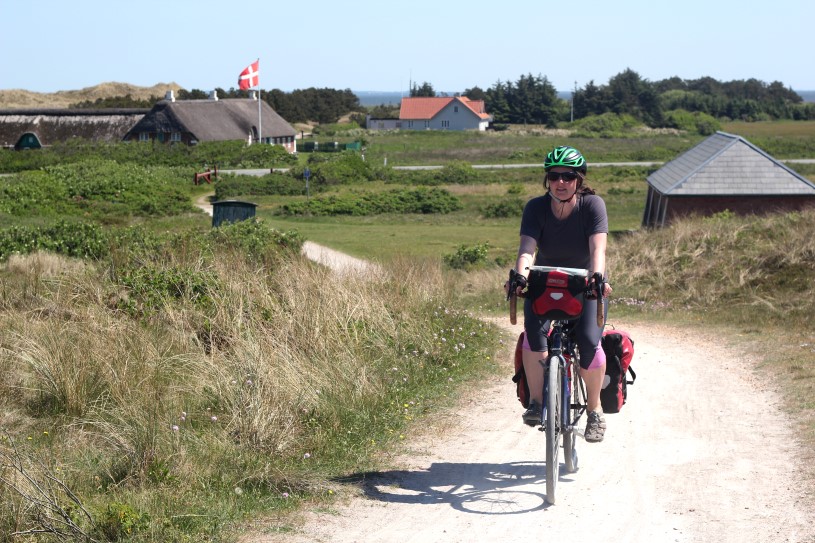
After a few days of unbroken sunshine and easy riding, we were nearing the end of our route: Skagen and the top of Denmark. The end of the peninsula is best known as the point at which the North and Baltic Seas collide. The turbulence of this conjoinment combined with the different densities of the two seas means that you can actually see the exact line at which they meet. Or so we had been told. After our long journey there – the trains, the bus, the cycling – we found there was one last hurdle: a long walk over the dunes in the midday heat. We ditched our bikes and shoes, and joined the line of pilgrims on their march to Denmark’s most northerly point, where we could all behold the spectacle for ourselves. We reached the end of the promontory and stood amidst the crowds, staring out to sea. Several minutes passed before I turned to Tim, puzzled.
“Can you see it?”, I asked.
“Nope”, he replied. “Not a thing”.
We eased our disappointment with a dip in both seas, before collecting our bikes and returning to the town. Skagen is well known for its artists, who were drawn there by its supposedly ‘magical’ light. However, we were more interested in the plentiful cafés. A couple of days stocking up on pastries fortified us for the long journey home, and as we looked back on Denmark from the train window we contemplated the fact that, on our next cycle tour, there would be three of us.
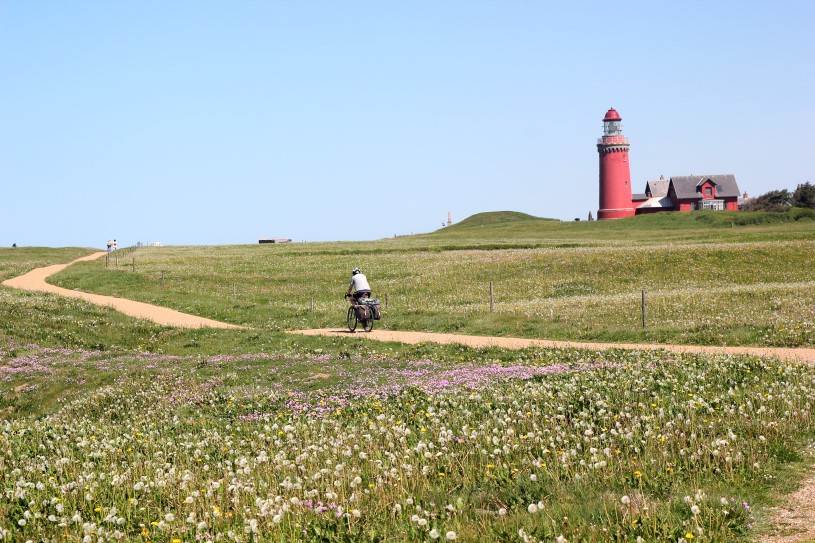
Do it yourself: Cycling the North Sea
Begin with the EuroStar to Brussels and an overnight Flixbus to Hamburg. Then you can either get a train to Klanxbüll near the Danish border, or start cycling up the Elbe as we did (you’ll be following a train line anyway). When you get to Skagen, hop on a train back to Flensburg. You’ll need a separate ticket for your bikes but they are easily obtained and inexpensive. From there, either switch trains or ride the final 180km back to Hamburg.
Alternatively, you could skip the trains and buses with a direct flight to Flensburg (60km ride from the southern end of the route) from London and Manchester. The route is well signposted and very easy to navigate. It would be easy to extend by riding more of the North Sea Cycle Route, riding back down the east coast or catching a ferry to Sweden or Norway from Frederikshavn or Hirtshals.
Trip fact file
Distances: 30-50 miles each day, around 450 miles in total
Route: Up the west coast of Jutland, from the German-Danish border at Rudbøl to Skagen on the northern tip. Vestkystruten is the official Danish name of the route, which also forms part of the North Sea Cycle Route. The route is 348 miles long, and we did some extra miles along the Elbe from Hamburg at the start.
Conditions: Windy but warm and sunny. We were lucky!
Accommodation: Regular campsites, which were reasonably priced: £10-£20 per night for the two of us. Wild camping is prohibited but isn’t necessary because of an extensive network of 600+ primitive campsites, which are largely free. Download the ‘Shelter’ app for a map of their locations.
Bikes: Ridgeback World Panoramas. We used slick 38mm tyres which worked well: just about coped with the sandy/off road sections and were still fast enough on the roads.
Glad I had: Swimming costume.
Next time I would: Make more use of the free campsites. Eat more pastries.
Useful websites:
- northseacycleroute.dk (route info)
- shelterapp.dk (to download the app showing free campsites)
- cycletourer.co.uk/cycletouring/denmark.shtml (general touring info)
This article originally appeared in Cycle magazine
What do you think? Please do add your thoughts below…